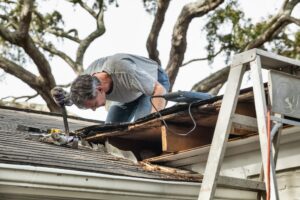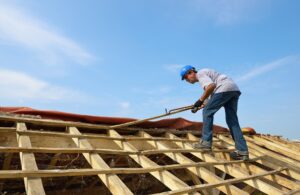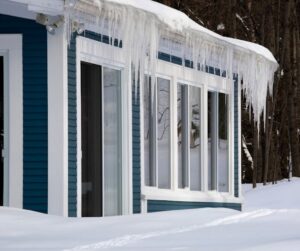After a major storm has struck your neighborhood, it’s time to clean up the debris and look around to see what’s damaged. But for your roof, you’ll need a professional inspection and often a professional repair. Here are four no-no’s to avoid when a storm damages your roof.
1. Hire a Door-to-Door Roofer
A roof contractor who shows up unannounced after a storm may very well be a storm chaser. Storm chasers are often unscrupulous or even inexperienced at roofing jobs, so it’s typically not in your best interests to hire them. They may offer a much better price than your usual roof contractor, but that the work they do is typically not comparable.
Whether they cut corners deliberately or whether they just aren’t very experienced, storm chasers aren’t likely to produce work that’s up to par with what you’d get from a local, reputable roofer. Plus, your local roofer doesn’t move from area to area following storms, so if you have problems with their work, you can call them up and get them to fix it.
To ensure the roofers you’ve chosen aren’t storm chasers, look for these signs:
- A valid license to do roof work in your local area (don’t just ask, look it up)
- The correct roofing insurance
- A physical office nearby that you can visit
- Previous customers in town who give good references
One of the major characteristics of less-scrupulous storm chasers is that they don’t have roots in the area; they just show up to take advantage of local storm damage. So check for these indicators to help you sort out the reliable local contractors from out-of-town companies looking to make a quick buck.
2. Nail a Tarp on the Roof
As a short-term solution, you may tarp over the damage on your roof while waiting for your scheduled roof repairs. If possible, hire a roofer for this job. (The roofer may have time to put an emergency tarp on your roof even if they have your repairs scheduled for a few weeks down the line). DIY tarping can be just as dangerous as any other DIY roofing job.
But ask your contractor not to nail the tarp to the roof. That just puts more holes in your shingles. So unless you’re already getting a total roof replacement, sandbags to hold the tarp down may be a better option.
3. Settle for a DIY Inspection
Many times, a storm will damage your roof in ways that require specialized knowledge to notice.
For example, if your flashing is in worse condition now than before the storm, spotting that it needs repair may take an experienced eye. Flashing problems can be hard to spot before a leak develops, so even if it looks okay to you, your flashing could still be storm-damaged.
Other types of easy-to-miss storm damage can include hail damage, which can cause either highly visible pockmarks or relatively inconspicuous damage to the fiberglass mat of the shingles. Hiring an experienced roofing contractor after each major storm minimizes the chances that some roof damage will sneak by you.
4. Put Repairs and Insurance in the Wrong Order
Roof repair may seem like the first priority, so your instinct may be to call your roof contractor before your insurance company. But if you want to get your insurance to pay for the repairs, follow your insurance protocols.
Your insurance company likely has a protocol that includes paperwork and an inspection from a designated insurance adjuster. If you don’t follow protocol, the company may deny your claim. You don’t want to pay for storm damage out of pocket. So call your insurance company first thing to make sure you know their protocol.





